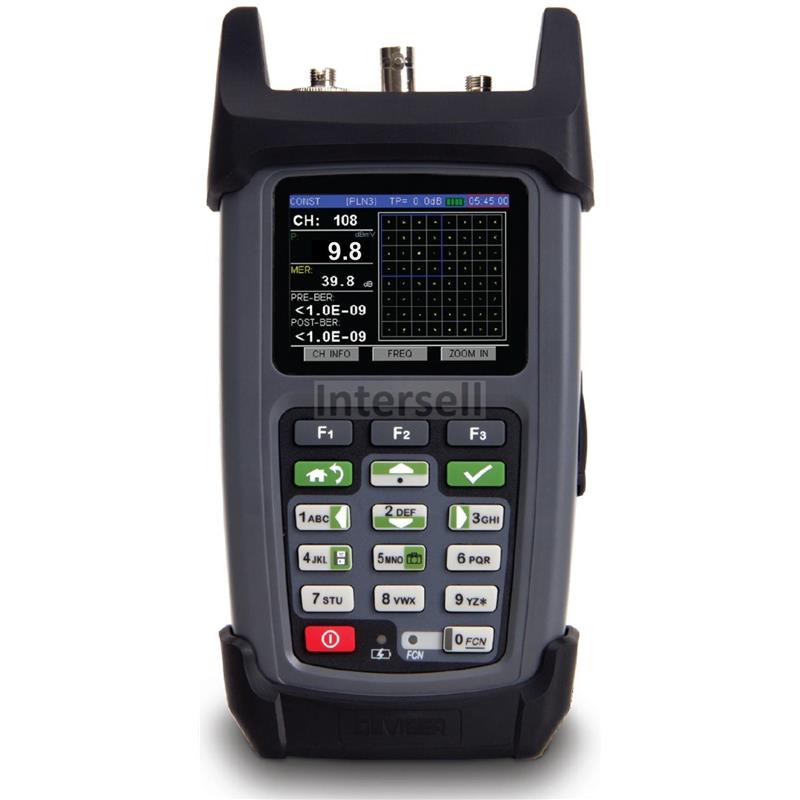




The QAM DS2460Q analyzer for analysis is a multifunctional instrument that works with digital QAM and analog signals in CATV networks. It is used to measure most parameters in digital TV (channel power, MER, BER, constellation diagram) and analog TV (single frequency level, full spectrum level of channels, noise). The device is great for initial network installation, service, and troubleshooting tasks.
The rugged design includes external enclosure protection, while the icon-based graphical user interface has programmable pre-set pass / fail boundaries. The easy-to-navigate menus are designed to increase the efficiency and productivity of technicians of all levels.
Other features - including return path scanning and forward scanning, 12 favorite frequency slopes, AC mains voltage test, noise and DC voltage measurements, combined with complete data logging and management software - make the DS2460Q a versatile tool in installations cable.
MER, Pre-Post BER, and statistics allow you to quickly verify loose connections, typically associated with pixel images or slow data flow over the DS Internet. Digital measurement functions also help identify mismatches caused by open concentric lines or impedance mismatch.
Features
Device design



Storage of up to 20 channel plans
For technicians and contractors who work on multiple HFC networks, having a choice of different channel plans is a must. The DS2460Q offers up to twenty different channel plans. When connected to an RF drop, the DS2460Q learns analog / digital channels and custom frequencies using the built-in automatic channel plan learning tool - or downloads them using Deviser's Toolbox PC software. The user can select up to 12 channels in each of the 20 custom-defined plans and assign them to a favorite tilt / channel plan.
QAM analysis and channel measurement
DS2460Q measures and analyzes channel power, MER and Pre-Post BER and displays constellation. It is compatible with 16/32/64/128/256 QAM modulations, and also enables power measurements for QPSK and COFDM digital carriers.
Spectrum analysis and measurement
The DS2460Q offers three different spectrum analysis modes: normal, fast and return path. Rapid spectrum analysis allows the technician to view the 5-1220MHz frequency range, while normal spectrum analysis optimizes the amplitude accuracy at a slower sweep speed.
To troubleshoot data transfer problems, the device can display the 5-65 MHz frequency ranges, providing an additional tool to data transfer technicians. All modes have access to Marker and Max Hold functions, making it easy to capture and analyze transient anomalies.
Full spectrum scan with marker function
The S2460Q can scan 160 channels, allowing users to quickly and efficiently measure the flatness and amplitude of an HFC network. Using markers, technicians can quickly identify mismatch anomalies caused by poor grounding or damaged transmission lines.
Noise measurements
HUM measurement helps technicians identify and troubleshoot problems that may arise from damaged capacitors, faulty line splitters, or overloaded couplers (due to weather conditions or excessive current). Both 60 Hz and 120 Hz tests at 400 Hz LPF are performed.
Automatic diagnostic test with user-defined limits
The automatic test simplifies the work of the technician by displaying positive / negative results. End users can set limits for power level, MER, Pre-Post BER, spectrum analysis, tilt and HUM analysis.
Thanks to the simple save function, the technician no longer has to manually save the results. This saves him more time on installation and servicing, and increases the efficiency of his work. Measurement data is saved immediately. This ensures performance accountability for each location and minimizes the need to return to previously tested locations.
File management - test data storage
Multiple test data files can be saved and stored as analog or frequency carriers, QAM or digital frequency carriers, channel scans, tilt measurements, frequency spectrum and / or noise measurements. The results are saved in the File Directory with a time stamp. Records can be transferred to a PC via the Toolbox software for report generation, printing and analysis.
Voltage measurement
The DS2460Q measures the voltage of the battery, line and distribution network of a cable system, accurately identifying AC or DC anomalies. The intelligent energy management system allows for about 5 hours of continuous operation from the battery when fully charged.
Sample measurements
MER, Pre-Ber, Post-BER and the constellation 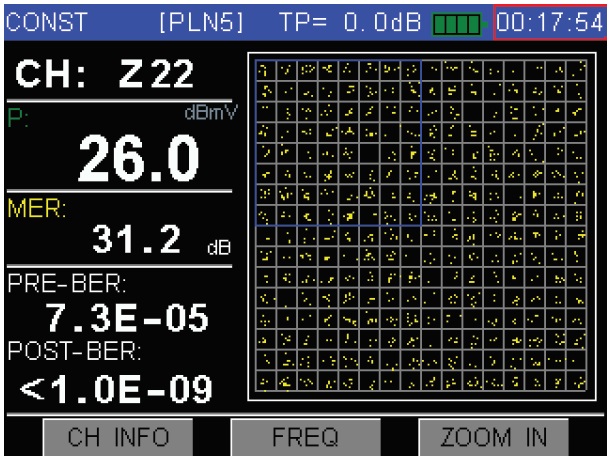 | BER 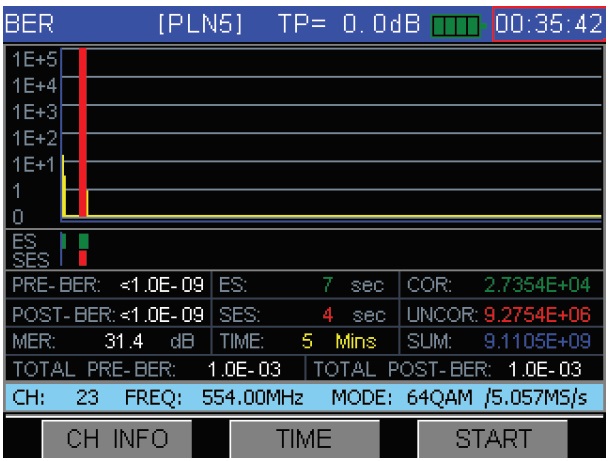 |
The spectrum of the reverse path 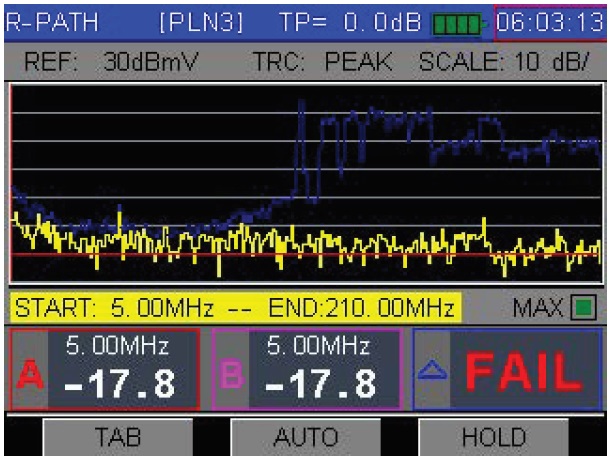 | Channel scan 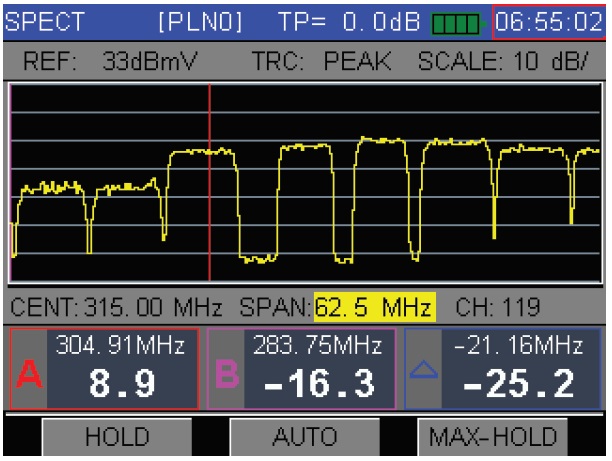 |
Tilt (max. 12 channels) 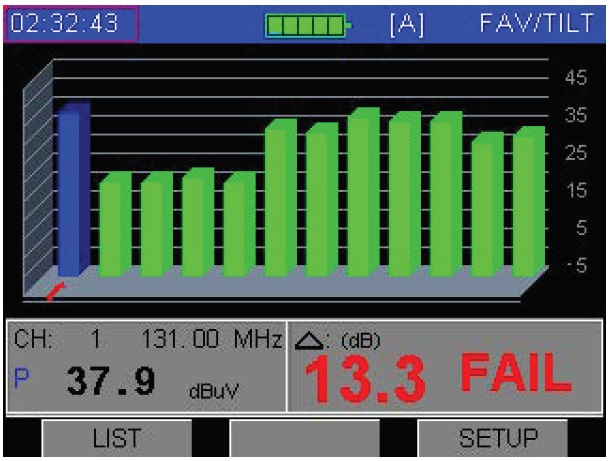 | Scan spectrum forward 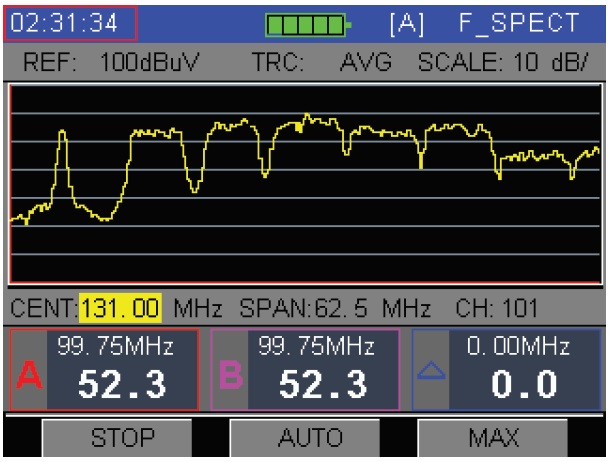 |
Normal spectrum analysis 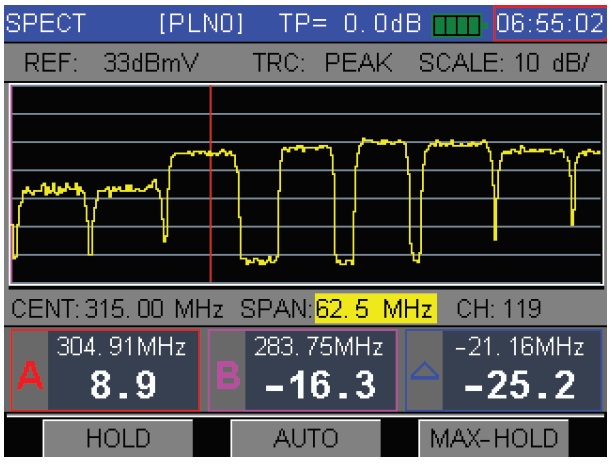 | Optical power meter function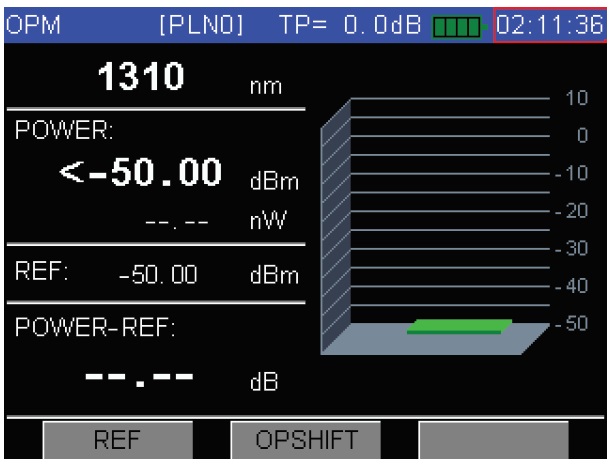 |
| Normal spectrum analysis | |
| Frequency range [MHz] | 45-1052 |
| Span [MHz] | 2.5, 6.25, 12.5, 25, 62.5, Full |
| Fast spectrum analysis | |
| Frequency range [MHz] | 5-1220 |
| Span [MHz] | 12.5, 25, 62.5, Full |
| Return path spectrum analysis | |
| Frequency range [MHz] | 5-210 |
| Channel scan | |
| Number of channels | 160 (max.) |
| Scale [dB / div] | 1, 2, 5, 10 |
| Approximation | 1X, 2X, 3X, 4X, 5X (5 levels) |
| Analog TV measurement | |
| Supported standards | PAL, NTSF and FM radio (single frequency) |
| Level measurement | Range: -30dBmV to + 60dBmV Accuracy: ± 2dB Resolution: 0.1dB |
| Frequency | Range: 5MHz to 1052MHz Accuracy: ± 50ppm Resolution: 10kHz |
| Bandwidth resolution [kHz] | 280 |
| C / N [dB] | > 50 |
| Noise measurement range [%] | 2 to 5 |
| Digital TV measurement | |
| Power level | Range: -30dBmV to + 60dBmV Accuracy: ± 2dB Resolution: 0.1dB |
| Frequency | Range: 46MHz to 1052MHz Accuracy: ± 2dB Resolution: 0.1dB |
| Supported standards | ITU-T J.83 annex A, B and C |
| QAM demodulation type | Annex A: QAM 16/32/64/128/256, Annex B and C: QAM64 / 256 |
| Interleave depth | 128x1 - 128x4 (J.83D) 12x17 (J.83A / C) |
| Symbol speed range [MS / sec] | 4 to 7 |
| MER [dB] | 41 Accuracy: ± 2dB |
| BER | 1E-3 to 1E-9 |
| Constellation display mode | 64/256 QAM with zoom capability |
| Line voltage measurement | |
| Range [V] | 0 to 100 (AC / DC) Accuracy: ± 2V |
| Optical power measurement | |
| Accuracy [dB] | ± 0.23 ( ± 5%) |
| Detector type | InGaAs Ø300µm |
| Range [dBm] | -50 to 27 |
| Linearity | 0.07dB / 10dB |
| Resolution | 0.01 dBm, mW, µW, nW |
| Wavelength [nm] | 850, 980, 1300, 1310, 1490, 1550, 1610 |
| Interface | FC / SC / ST Universal Connector Interface Adapter |
| Visual fault location (VFL) | |
| Output power [mW] | 10 |
| Output wavelength [nm] | 650 ± 10 |
| Protection standards | IEC 60825-1: 2007 |
| Interface | FC / PC |
| General parameters | |
| Dimensions [mm] | 200 x 106 x 54 (7.9 "x 4.2" x 2.1 ") |
| Weight [g] | around 600 |
| Display | 2.8 "TFT LCD 320x240 |
| Power | AC / DC Adapter (AC: 100-240V, 50 / 60HZ, DC: 15V / 0.9A) 7.4V 2.5Ah lithium battery |
| Battery operation time [h] | > 5 |
| Battery charging time [h] | 5 |
| RF input | 75? |
| USB | MicroUSB B 2.0 |
| Ethernet | 10 / 100M |
| Working conditions | Ambient temperature: -10 to 40 [° C] |
| The storage conditions | Ambient temperature: -20 to 70 [° C] |
Manufacturer
Responsible person
Informacje o bezpieczeństwie
1. Zasilanie (dotyczy produktu zasilanego energią elektryczną)
Urządzenie może być zasilane zarówno z sieci elektrycznej, jak i z wbudowanego akumulatora (jeżeli dotyczy urządzęń z akumulatorem).
Podczas pracy z zasilaniem sieciowym należy stosować wyłącznie oryginalny zasilacz i przewód zasilający dostarczony przez producenta.
Nie wolno używać urządzenia w środowisku wilgotnym ani w pobliżu źródeł ognia.
W przypadku uszkodzenia przewodu zasilającego lub widocznych śladów uszkodzeń obudowy należy natychmiast odłączyć urządzenie od sieci i zaprzestać jego użytkowania.
Akumulator należy ładować wyłącznie przy użyciu dedykowanej ładowarki. Nie należy podejmować prób otwierania, rozbierania ani wymiany akumulatora na własną rękę.
2. Promieniowanie laserowe (dotyczy urządzeń z wbudowanym nadajnikiem laserowym)
Urządzenie zawiera źródło laserowe. Promień lasera jest niewidoczny dla ludzkiego oka, ale może być niebezpieczny.
Nigdy nie należy patrzeć bezpośrednio w zakończenia światłowodu ani do wnętrza portów optycznych, gdy urządzenie jest włączone.
Nie wolno kierować promienia lasera w stronę oczu ludzi ani zwierząt.
Prace instalacyjne i serwisowe powinny być wykonywane wyłącznie przez osoby posiadające odpowiednie przeszkolenie z zakresu bezpieczeństwa pracy z laserami.
Oznaczenia bezpieczeństwa i etykiety ostrzegawcze umieszczone na urządzeniu nie mogą być usuwane ani zasłaniane.
3. Bezpieczeństwo przy pracy ze światłowodami
Odcinki i resztki włókien światłowodowych mogą być bardzo ostre – istnieje ryzyko zranienia skóry oraz wniknięcia w tkanki.
Wszelkie prace związane z cięciem, obróbką czy usuwaniem włókien powinny być wykonywane w rękawicach ochronnych i na odpowiedniej powierzchni roboczej.
Odpady światłowodowe należy gromadzić w zamkniętych pojemnikach i utylizować zgodnie z zaleceniami BHP.
4. Ogólne zasady bezpieczeństwa
Przed rozpoczęciem pracy należy zapoznać się z całą instrukcją obsługi i przestrzegać zaleceń producenta.
Urządzenie powinno być używane wyłącznie zgodnie z jego przeznaczeniem – do pracy z sieciami światłowodowymi.
Nie należy ingerować w konstrukcję urządzenia ani dokonywać samodzielnych napraw.
W przypadku zauważenia nietypowego zapachu, dymu, przegrzewania się lub nieprawidłowego działania, należy niezwłocznie odłączyć urządzenie od zasilania i skontaktować się z serwisem.
Urządzenie oraz wszelkie elementy światłowodowe muszą być zawsze przechowywane i użytkowane z dala od dzieci.